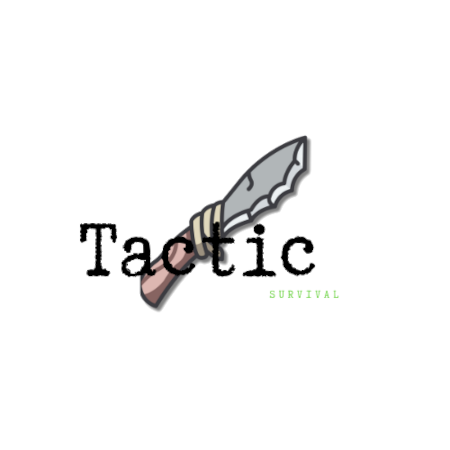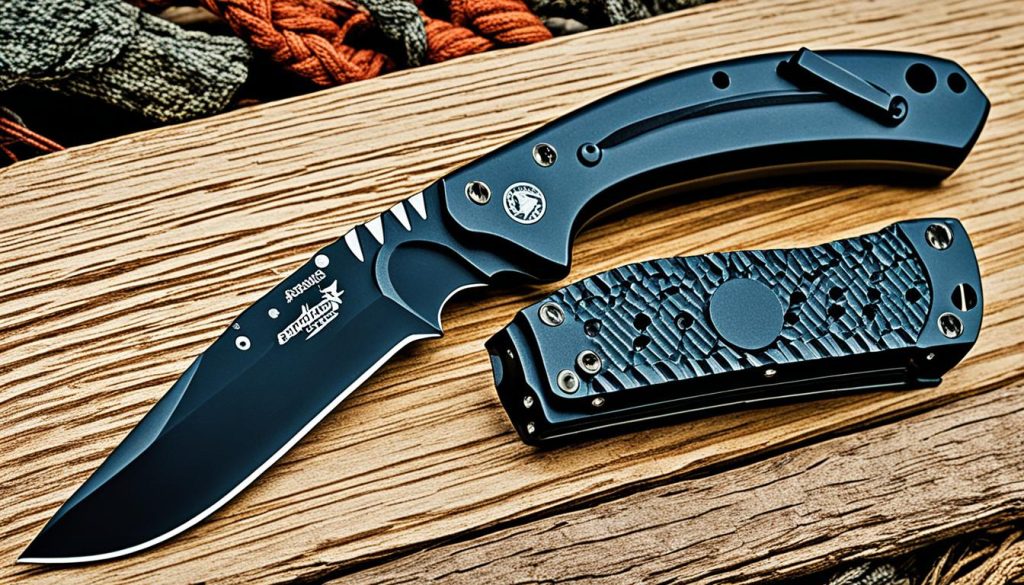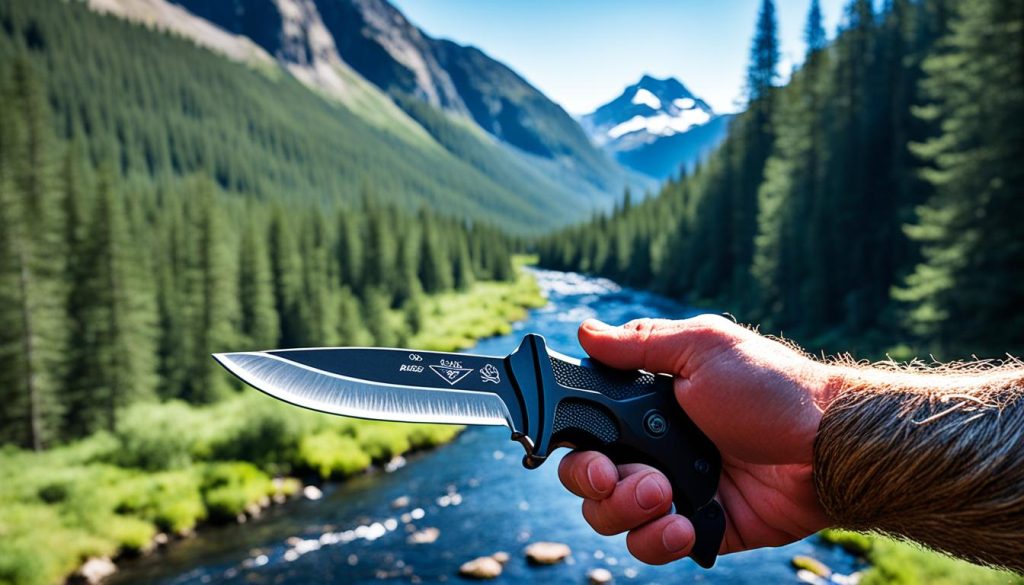Did you know that a reliable survival knife can mean the difference between life and death in an emergency situation?
When disaster strikes, having the right tool at your fingertips is crucial. A well-chosen survival knife can assist you in a variety of tasks, from building shelter to preparing food, making it an indispensable asset in challenging circumstances.
In this comprehensive guide, we will walk you through the essential factors to consider when choosing a survival knife, including blade materials, handle design, and overall functionality. Whether you’re an outdoor enthusiast, prepper, or adventurer, this guide will help you make an informed decision and find the best survival knife to meet your needs.
Key Takeaways:
- Understand the important features of a good survival knife, including a tough blade, comfortable grip, full-tang construction, versatile blade shape, and solid sheath.
- Explore the different types of steel used in survival knives, such as carbon steel, stainless steel, and tool steel, to find the right balance of strength and corrosion resistance.
- Consider the intended use, size, weight, tang type, blade grind, and handle materials when selecting a survival knife that suits your needs.
- Ensure the survival knife comes with a reliable sheath for safe storage and transportation.
- By carefully evaluating these factors, you can choose a durable, reliable, and versatile survival knife that will serve you well in any survival situation.
Understanding Different Steel Types for Survival Knives
When it comes to survival knives, the type of steel used in the blade plays a crucial role in its performance and durability. There are three main categories of steel commonly used for survival knives: carbon steel, stainless steel, and tool steel.
Carbon Steel
Carbon steel is known for its toughness and ease of sharpening, making it a popular choice among survivalists. However, carbon steel blades are prone to rust and require proper care to prevent corrosion. One common type of carbon steel used in survival knives is 1095 steel, which offers excellent strength and edge retention.
Stainless Steel
Stainless steel blades are highly resistant to corrosion, making them a reliable option for survival knives. However, stainless steel may be slightly harder to sharpen compared to carbon steel. There are various types of stainless steel used in survival knives, including VG10, CoS, Sandvik 12C27, AUS8, and Böhler N690. These stainless steel options provide a good balance between corrosion resistance and blade sharpness.
Tool Steel
Tool steel is a versatile option that combines the qualities of carbon steel and stainless steel. It offers excellent rust resistance and durability, making it suitable for demanding survival tasks. Popular types of tool steel used in survival knives include Sleipner and D2, known for their exceptional strength and edge retention.
When choosing a survival knife, the selection of steel type depends on individual preferences and the intended use of the knife. Carbon steel blades are ideal for those who prioritize ease of sharpening, while stainless steel is a good option for those looking for corrosion resistance. Tool steel is a reliable choice for those who want a balance between the two. Consider the specific qualities and advantages of each type to select the steel that best fits your needs.
Essential Features to Consider When Choosing a Survival Knife
When it comes to selecting a survival knife, certain features are essential to ensure its durability, functionality, and reliability in challenging situations. A well-designed survival knife should possess these key features:
- Tough and Easy-to-Sharpen Blade: The blade of a survival knife should be constructed from a material that can withstand demanding tasks and retain its sharpness even in harsh conditions. This makes it ideal for long-term use in the field without the need for frequent sharpening.
- Comfortable Grip Handle: A comfortable grip is crucial to maintain control and prevent hand fatigue during extended use. Look for handles made from materials such as micarta or rubber, which offer excellent grip and ensure a secure hold, even in wet or slippery conditions.
- Full-Tang Construction: A full-tang construction means that the blade extends the entire length of the handle, providing exceptional strength, stability, and durability. This feature enhances the balance of the knife and ensures its ability to withstand heavy-duty tasks.
- Versatile Blade Shape: The blade shape of a survival knife plays a significant role in its versatility. Different blade shapes like drop point, clip point, tanto, and spear point offer unique advantages, making the knife suitable for various survival tasks, from slicing and piercing to detailed cutting.
- Solid Sheath: To protect both the user and the knife, a solid sheath is a must-have accessory. It provides secure storage, easy access, and safe transportation of the survival knife. A well-designed sheath will keep the knife in place and protect it from accidental damage.
By considering these essential features, you can confidently select a survival knife that meets your needs and is capable of withstanding the demands of any survival situation.
Example of a Durable Survival Knife:
The XYZ Survival Knife is an excellent example of a durable and reliable option. Its tough and easy-to-sharpen blade, comfortable grip handle, full-tang construction, versatile blade shape, and solid sheath make it an ideal choice for outdoor enthusiasts and survivalists alike.
| Features | Description |
|---|---|
| Tough and Easy-to-Sharpen Blade | The XYZ Survival Knife’s blade is crafted from high-quality carbon steel, offering exceptional toughness and the ability to hold a sharp edge for extended periods. |
| Comfortable Grip Handle | The XYZ Survival Knife features a ergonomic handle made from micarta, which provides a secure and comfortable grip, even in wet or slippery conditions. |
| Full-Tang Construction | With its full-tang construction, the XYZ Survival Knife delivers optimal strength, balance, and durability, ensuring it can handle the toughest survival tasks. |
| Versatile Blade Shape | The XYZ Survival Knife boasts a drop point blade shape, which combines a sharp point for piercing with a robust belly for slicing, making it versatile for a wide range of survival scenarios. |
| Solid Sheath | The XYZ Survival Knife comes with a durable and secure sheath, allowing for safe storage and easy access when needed. Its design ensures the knife remains protected during transportation and minimizes the risk of accidental injuries. |
Tips for Choosing the Right Survival Knife
When it comes to selecting the perfect survival knife, there are several important factors to consider. By understanding these key aspects, you can ensure that you make an informed decision that meets your specific needs. Here are some valuable tips to help you choose the right survival knife:
- Consider the intended use and environment: Different survival situations require specific features and materials. Think about the tasks you’re likely to encounter and the conditions you’ll be facing.
- Size and weight matter: Make sure to factor in the size and weight of the survival knife. It should be comfortable to carry and handle, allowing you to maneuver with ease.
- Balance blade length and overall size: Aim for a balance between blade length and the knife’s overall size. A blade length of 4-7 inches is generally recommended as it offers versatility in various survival tasks.
- Consider the type of tang: The tang type of a knife significantly impacts its strength and durability. Opt for a full-tang or rat’s tail tang, as they offer superior reliability and stability.
- Choose the right blade grind and edge: The blade grind and edge play a vital role in the knife’s performance. Consider a saber grind or compound bevel, as they offer easy sharpening and good edge retention.
- Handle material and design: The handle of a survival knife should provide comfort and a secure grip. Synthetic materials like micarta and rubber are popular choices due to their durability and excellent grip.
- Ensure a reliable sheath: A reliable and secure sheath is essential for safe storage and transportation of your survival knife. Make sure it fits the knife properly and offers quick and easy access.
By keeping these tips in mind, you can confidently select the right survival knife that will be your trusted companion in any challenging situation.
| Choosing the Right Survival Knife | |
|---|---|
| Intended Use and Environment | Consider the specific tasks and conditions you’ll encounter. |
| Size and Weight | Ensure the knife is comfortable to carry and handle. |
| Balance Blade Length and Overall Size | Opt for a blade length of 4-7 inches for versatility. |
| Type of Tang | Choose a full-tang or rat’s tail tang for strength and durability. |
| Blade Grind and Edge | Select a saber grind or compound bevel for easy sharpening and good edge retention. |
| Handle Material and Design | Consider synthetic materials like micarta and rubber for comfort and grip. |
| Reliable Sheath | Ensure the knife comes with a secure sheath for safe storage and transportation. |
Conclusion
After carefully considering various factors such as blade material, handle design, and overall functionality, choosing the best survival knife becomes a crucial decision. The right survival knife should be durable, reliable, and versatile, capable of handling a wide range of tasks in different survival situations.
By understanding the features and options available, you can make an informed decision and select a survival knife that best suits your needs and preferences. Whether you need a tough carbon steel blade or a corrosion-resistant stainless steel option, it’s important to choose a knife that can withstand demanding tasks and be easily sharpened in the field.
To make your selection easier, check out this comprehensive guide on how to choose the best survival knife for your situation. It provides in-depth reviews, expert recommendations, and valuable insights to help you find the perfect tool to accompany you in your outdoor adventures. Remember, a well-chosen survival knife can be a reliable companion and a valuable asset when faced with unforeseen challenges.


